Crime and COVID-19 in Mexico: Some Counterintuitive Results
Sean Fiorella, Tony Payan, Daniel Potter, and Rodrigo Montes de Oca Arboleya
At the onset of the COVID-19 pandemic in early 2020, governments around the world began implementing a series of public health measures to limit transmission of the virus that causes the disease. Two such measures were social distancing and stay-at-home orders, both of which were meant to reduce human mobility and contact, and thus slow down the spread of the infection. These measures in turn provided scientists with a natural experiment to study other social phenomena that hinge precisely on human mobility and contact. One of these is criminal activity. Expectedly, the literature focused on the interaction between COVID-19—with the corresponding measures to contain it—and criminal activity prior to and during the months of the pandemic has grown substantially. This study adds to this literature by addressing the relationship between COVID-19 and criminal activity in the Mexican case, comparing the pre-pandemic and pandemic periods of time and examining the interaction of these variables at both the national and subnational levels.
Literature Review and Goals of the Study
The literature on disruptive events and crime is well-established. Cohen and Felson (1979) argued that structural changes in routine activity and daily patterns can influence crime rates.[1] The relevant reasoning is that, for crime to occur, there must be motivated offenders, suitable targets, and the absence of capable guardians against a violation, but also predictability in mobility patterns. Given these conditions, disruptive events provide ideal natural experiments to study criminal activity. Looking at the 2005 Katrina hurricane in Louisiana, for example, Leitner et al. (2011) examined crime in several Parishes from 2001 through 2006, finding that crime, including homicide, remained relatively stable, with only a few Parishes experiencing sharp increases or decreases in the overall crime rate in the year after hurricane Katrina.[2] Similarly, Frailing and Harper (2017) found that homicide in New Orleans decreased after hurricane Katrina from September to December 2005, but increased drastically through 2006 and 2007.[3] Following on this line of research, and looking at the Coronavirus pandemic, Ashby (2020) made the case that there were no significant changes in the frequency of serious assaults in public or (contrary to the concerns of policy makers) any change to the frequency of serious assaults in residences during the pandemic.[4] He further found that in some cities, there were reductions in residential burglary but little change in non-residential burglary. Simultaneously, thefts of motor vehicles decreased in some cities but there were diverging patterns of thefts from motor vehicles. In general, studies such as these provide a relevant path for experimental research designs, including those looking at the relationship between COVID-19 and crime over time in Mexico because they posit a similar theoretical relationship between structural and social disruptions, such as the before and after hurricane Katrina in all the affected Parishes of Louisiana, and crime.
Several other studies have already added to the line of research undertaken in this study. Three such works are the analyses by Balmori de la Miyar, et al. (2021) [5] and Estévez-Soto (2021).[6] These two studies examined the relationship between the COVID-19 pandemic and crime patterns in Mexico City, the national capital. Balmori de la Miyar et al. (2021) also examined changes in Mexico’s national crime rates after national lock down restrictions were eased from June to October 2020, but they do not focus on the pre-pandemic and pandemic levels comparatively.[7] Thus, unlike most of the existing literature which examines COVID-19 and the kind of structural changes in routine activity that can be caused by government mandates to stop a pandemic, this study looks at the country’s trends in general prior to and during the pandemic and then at both the national level and at each of the thirty-two states separately throughout the year prior to and the first year of the COVID-19 pandemic. It also considers organized versus conventional crime by association—although admittedly (and justifiably), it is assumed that homicide and vehicle theft at more closely related to organized crime, while muggings and domestic violence are not.
To summarize, in order to advance the analyses of the relationship between COVID-19 and criminal activity, the model proposed in this study involves three key elements: 1) Four types of crime—two generally associated with organized crime (homicide and vehicle theft), an important issue in the Mexican criminal landscape, and two conventional crimes (muggings and domestic violence); 2) an examination of changes in crime trends at the national and subnational levels; and 3) a comparison between the pre-pandemic and pandemic crime levels.
Research Questions
Given the current state of research examining the COVID-19 pandemic’s influence on criminal activity, this study set out to test four interrelated research questions. First, it aimed to test whether different criminal activities, specifically vehicle theft and homicide (closely related to organized crime) and domestic violence and muggings (conventional crimes), behaved differently in relation to the COVID-19 pandemic. For that, it sought to determine whether different crime rates responded differently over time, specifically 12 months before and 12 months after the COVID-19 pandemic. Second, it sought to determine whether different crime rates responded differently not only at the national level but also in the thirty-two different states that Mexico is composed of during the periods under examination. A final research question sought to understand how responsive crime rates across all states in Mexico were to the severity of COVID-19 infection rates.
Case Study Choice
The Mexican case provides sufficient elements to examine the relationship between COVID-19 and measures to contain its spread, specifically social distancing and stay-at-home orders, and criminal activity. Some caution is in order, however. Mexico exhibited a lax attitude toward enforcement (government side) and compliance (population side) of anti-COVID-19 measures to contain the spread of the disease, specifically in regard to the stay-at-home and social distancing orders. Even so, serious efforts were made on both ends. On the enforcement side, the federal government created a “semaphore” in May 2020, which was to allow state governments to apply greater or lesser restrictions on human mobility based on levels of COVID-19 locally. This is an important reason to delve into an examination of state-by-state conditions, even if the federal government never gave an entirely clear message regarding the seriousness of the pandemic.[8] Further, most governors did take their role in enforcing certain measures seriously. On the compliance side, many citizens never fully observed and even ignored—or were unable to comply with—the measures, mostly because they had no source of income other than their daily work. This was particularly true in the large informal economy that exists in Mexico. Consequently, in many places, measures were implemented and relaxed repeatedly. Still, despite limitations on enforcement and compliance with anti-COVID-19 measures, the data shows that mobility did decrease during the pandemic to make it worthwhile analyzing the correlation between these COVID-19 and criminal activity prior to and during the pandemic. Reports from Mexico City, for example, indicate that Mexicans avoided traveling longer distances and using public transportation following the onset of COVID-19 and the corresponding government orders.[9]
Second, the Mexican case is also suitable to test the research questions posited in this study because, while criminal activity levels have fluctuated over time, they have stabilized at roughly the same level since 2019, just prior to the pandemic, and have remained there through 2023, allowing for control of prior wild variations over time. There is, of course, a level of crime underreporting in Mexico, but it is assumed, justifiably, that it too has remained fairly constant, as nothing points to a correction in crime reporting rates over time.
Third, not all types of crime are the same or respond the same way to structural or social change. For example, Lewis and Alford (1975) and Anderson and Malleson (2013) posited that certain types of crime can be seasonal, increasing or decreasing based on the time of year.[10][11] Thus, variances in crime rates call for crime seasonality adjustments. This study controls for just this kind of seasonal variance. Similarly, in the Mexican case, some types of crime are more closely associated with organized crime and others are more conventional in nature. Thus, an added contribution by this study relates to the fact that Mexico is a country experiencing two types of crime that might theoretically interact differently with COVID-19—organized crime and conventional crime. The relationship of the pandemic with each of these two types of crime may vary and must be considered by any model that purports to explain the relationship between COVID-19 and criminal activity. On this score the Mexican case may be ideal for our research design, as both types of crime are broadly present in the country and each type of crime separately adds nuance to the study. More specifically, this research examines the crimes of homicide, vehicle theft, muggings, and domestic violence. Of these, the first two are more closely associated with organized crime, with homicide being the most serious crime. Mexico’s increased homicide rate over the last 15 years has been largely attributed to organized crime and the Mexican Drug War launched in 2006. Despite the increased levels of homicide nationally, these increases have not been constant across each state, due to the differing levels of organized crime presence within each state. Similarly, vehicle theft is primarily associated with organized crime, because it is largely committed by organized criminal groups, who dismantle the stolen vehicles and sell them for parts or sell them to organized criminals who use them to commit other offenses.[12][13] On the conventional crime axis, our research aims to understand the influence of COVID-19 and government mandates on conventional crime, such as muggings and domestic violence, in the months following the onset of the pandemic. By examining changes in both organized and conventional crime rates for each individual state, this should result in a clearer picture of the crime rates across all states in Mexico during the first year of the COVID-19 pandemic.
Fourth, Mexico is not only a large country, with important regional variations, but also a federation, and its component units or states are quite different. This allows testing of the relationship between COVID-19 and criminal activity across all thirty-two states of Mexico and the national aggregate level—obligated and convenient because, as it was stated, the semaphore allowed for variation in subnational responses. This approach is likely to render a broader view of the relationship between COVID-19 and crime, as not all states are likely to be affected equally nor are they affected the same over time.
A bonus of the Mexican case is that it can contribute to understanding of other similar cases in Latin America, a region of the developing world with high levels of criminal activity.
Data and Methods
In our statistical analysis, we combined datasets published by the federal government in Mexico on criminal activity (federal and state by state), COVID-19, and population demographics. Additionally, we used data from the private sector, specifically Apple, to examine mobility prior to and during the COVID-19 pandemic.
Crime Data
The Executive Secretariat of the National Public Security System (SESNP) is the governmental body in charge compiling data on various types of criminal activity every month at the federal, state, and municipality levels. The SESNP database was established in 2015, and it is organized by state, type of crime, and motive, while tallying the incidents of each occurrence of crime by month. The SESNP database provides the most reliable and comprehensive aggregate of crime data by state in Mexico.
SESNP data were used to create variables on homicide, vehicle theft, muggings, and domestic violence crime rate. For homicide, we tallied the count of all manslaughters and homicides, regardless of whether they were labeled intentional or culpable or the modality in which the act occurred. For vehicle theft, we tallied the count of all vehicle and motorcycle thefts, regardless of motive. For mugging, we examined the listed theft and robbery subcategories and aggregated the count of robberies from passersby on streets and spaces open to the public, regardless of whether the incident was perpetrated with or without violence. For domestic violence, we used the SESNP variable measuring the number of reported incidents of domestic violence. Each type of crime was then converted to a crime rate by dividing the counts of crime type by each specific state’s population from our census data and then multiplying by 100,000.
COVID-19 Data
For our study we used the official Mexican COVID-19 database, published by the Epidemiological Surveillance System for Vital Respiratory Diseases of the Mexican Ministry of Health.[14] The Mexican COVID-19 database maintains record of all cases of COVID-19 by assigning patients unique identification numbers that provide demographic data, such as age, sex, nationality, and state residence, as well as medical information to include date of the onset of symptoms, date of testing for COVID-19, risk factors, state where the patient was admitted for care or services, and date of death if applicable. For our analysis, we created a dependent variable of the COVID-19 case rate where the monthly number of COVID-19 cases for each state were tallied, divided by the state population and multiplied by 100,000. This dependent variable of the COVID-19 infection rate was also used as a proxy for government mandates and restrictions, assuming as rates of COVID-19 transmission increased in each state, so would government mandates and restrictions.
Census Data
To control for state population, we utilized the 2020 Census of Population Housing Data published by the National Institute of Statistics and Geography (INEGI). The census conducted in 2020, utilized the de jure method, which tallied people according to their legal residence from 2 to 17 March. Data were collected using a basic questionnaire to determine not only population by state, municipality, and locality, but demographic data as well. For the purposes of this study, we only used the aggregate count of the population by each of the 32 Mexican states in order to create rates of both specific types of crime as well as COVID-19 cases.
Mobility Data
To map out the structural changes in routine activity among Mexicans and how it may have changed at the onset of the COVID-19 pandemic, we used Apple Mobility Data. This helped create a visual representation of mobility trends over time. This data provides the volume of direction requests by transportation type (walking, driving, and public transportation) for all Apple users by day for all of Mexico and several states and major cities compared to the baseline volume of requests beginning on 13 January 2020. For the purposes of our research, we only viewed the Mobility Data for all of Mexico, rather than by city or state from 13 January 2020 through 28 February 2021.
Discussion on the Data
In conducting a study, it is important to consider imperfections in the data. Regarding crime data, when examining it, it must be understood that the SENSP data does not delineate whether an occurrence of a crime was perpetrated by organized criminal actors, nor does it make the distinction as to whether certain types of crime are considered organized or conventional. Nonetheless, in the general literature regarding Mexico, some types of crimes are associated with organized crime, including homicide and vehicle theft and others with conventional crime, including muggings and domestic violence.
Also, crime reporting in Mexico is low. According to the National Survey of Victimization and Public Security 2020, a survey conducted by the INEGI, during 2019, the unreported crime rate was 92.4%, meaning that authorities only opened investigations on 7.6% of all crimes that occurred.[15] This was also confirmed in a conversation with David Pérez Esparza, head of Mexico’s National Center of Information (CNI), indicating that available data accounts for only about 10% of all crimes committed in Mexico. This disparity between occurrences and crimes reported stems from several sources. First, victims and/or witnesses are generally hesitant to report a crime because they do not trust that justice will be carried out or because the pervasive corruption within Mexico’s justice system had led to a deep mistrust in government, making citizens less likely to report crime.[16] Additionally, not all crime is reported equally. Also, some studies have shown that violent crimes typically associated with organized crime are less likely to be reported due to witness or victim intimidation or fears of retaliation from Mexico’s criminal organizations through the use of “narco-messaging.”[17][18] Even so, the data is representative of all criminal activity in Mexico.
Now, different government databases vary as different agencies and levels of government keep records differently, resulting in disparate data. A México Evalúa investigation in 2016, for example, found substantial differences in homicides reported by the National Institute of Statistics (INEGI) and SESNP, which is the official record of crime data used by the Mexican government in crime prevention and reduction policy formulation.[19] This report also provides evidence of misreporting of crime by various municipalities across Mexico with several occurrences of homicides and other crimes associated with organized criminal activity were often misbranded or mischaracterized as non-violent, which misconstrues the data to show lower levels of violent crime.[20]
Also, conventional crimes otherwise unassociated with criminal organizations, such as domestic violence, have the potential to be underreported because of cultural aspects and institutional barriers required to report crime. On the first score, although domestic violence is a global issue, family loyalty and cultural attitudes such as “machismo” are unique Latin American social constructs, which may yield to under reporting of incidents of domestic violence in Mexico.[21] On the second score, David Pérez Esparza explains that the structural barriers required to report crime in Mexico, such domestic violence, can inhibit an accurate summation of incidents. When an incident of domestic violence occurs in Mexico and emergency services are notified, local police are dispatched to the scene of the incident which often de-escalates the situation. In the end, victims often decline to file a report after the situation has been defused by local police, leading to an under reporting of domestic violence overall. Moreover, when victims are instructed to file a report with the Office of the Attorney General so that an investigation can be initiated, which feeds the data obtained and published by SESNP, there are onerous requirements to ratify reports, often several times, leading many victims to give up on going through the entire process.
In addition to limitations of the available crime data, there are also limitations of accuracy of Mexico’s COVID-19 case and death numbers. According a revised report issued by Mexico’s Ministry of Health in March 2021, the official Mexican death toll due to COVID-19 was increased by 60% after a review of excess deaths across each state in Mexico and review of death certificates since the start of the pandemic.[22] These disparities are likely connected to the limited availability in testing for COVID-19 during the spring of 2020, where Mexico ranked last amongst all Organization for Economic Co-operation and Development (OECD) countries, testing only 0.4% of their population for COVID-19.[23]
While Mexico’s ability to test for COVID-19 gradually improved as the pandemic waged on, there are limitations in using the COVID-19 infection rate as a proxy for government mandates and restrictions. This study acknowledges that mobility data would have been a much better proxy for understanding the relationship of government mandates such as social distancing and stay-at-home orders on crime, rather than the COVID-19 infection rate, as mobility data would have provided a clearer picture as to what the citizens of Mexico did – regardless of the COVID-19 rate or government mandates aimed at reducing transmission. Despite this, the Apple Mobility data was not included in our models for analysis because our research examines crime rates over time, beginning in March 2019, and the available data begins in January 2020. While there are mobility data prior to the pandemic, using an average or similar measure would disregard the potential seasonality of mobility or leisure activities. Most importantly though, there are no data available for all states in Mexico. Though the data available could be extrapolated from the national average, no variance between states would exist therefore rendering any variable incapable of explaining any of the state-to-state variances in crime.
Analytical Strategy
Our research strategy was conducted in three stages to examine our four research questions. Our first stage sought to understand the first two research questions: a) Did different crime rates respond differently to the COVID-19 pandemic? and b) Did they respond differently over time? Our second stage of analysis answered the third research question: c) Did different crime rates respond differently over time across states in Mexico? The final stage addressed the fourth research question: d) How responsive were crime rates across all states in Mexico to the infection rate of COVID-19?
Results
This section presents the results of the analysis conducted by the authors, attempting to answer all the questions posed for the research.
Did Different Crime Rates Respond Differently to COVID-19 and Over Different Times?
First, to determine if different crime rates responded differently to COVID-19 or if crime rates responded differently over time, we adjusted for the seasonality of crime by organizing crime rates into six-month periods, consisting of two periods before and two periods after the onset of the pandemic. The two six-month periods before the onset of the pandemic spanned from March 2019 to August 2019 (period 1) and September 2019 to February 2020 (period 2). The two six-month periods after the start of the pandemic spanned from March 2020 to August 2020 (period 3) and September 2020 to February 2021 (period 4). Creating these four six-month periods for comparison enabled our research to minimize the influence of seasonal changes in crime.
To test our first two research questions, we created paired sample t-tests to determine whether, on average, there were changes in crime rates before and after the start of the pandemic. In our paired sample t-tests we analyzed each crime rate separately across all states in Mexico, contrasting period 1 (March – August 2019), against period 3 (March – August 2020), and then period 2 (September 2019 – February 2020), against period 4 (September 2020 – February 2021). Given the limited size of our sample (i.e., states in Mexico), significance is set at p < 0.10.

Table 1. t-test Results Comparing Crime Rates Before and After the start of the COVID-19 Pandemic.
Results from our paired sample t-tests indicated that certain crime rates did in fact respond differently to COVID-19, and certain crime rates also responded differently over time. Specifically, our research determined that during the first six months of the pandemic only the crimes of muggings and vehicle theft decreased and were statistically significant, while domestic violence and homicide were relatively unchanged compared to the same time from the previous year. As the pandemic continued beyond six months, these trends continued for both muggings and vehicle theft rates, however our research found that domestic violence increased and was statistically significant as well. Lastly, our results concluded that throughout the first 12 months of the pandemic, homicide rates across all states in Mexico were unchanged compared to the previous 12 months before the pandemic.
Did Different Crime Rates Respond Differently to COVID-19 over Different Times in Different States?
Building upon our first stage of analysis, our researched aimed to understand if different crime rates responded differently to COVID-19 over different times in different states. To examine this, we created multiple linear regression models to estimate each of the crime rates for each state controlling for population size. After the initial regression model, a marginal analysis was used to calculate the mean predicted value of average monthly crime rate by state for the four six-month periods. Using these average monthly predicted values, the differences in rates between periods were calculated, enabling the research to show the sequential changes between each of the four periods, and focus comparisons on the same “season” by comparing periods 1 and 3 and period 2 and 4 respectively.
To determine which states experienced a substantive change in crime rates sequentially between periods and after the onset of COVID-19, we calculated the descriptive statistics to determine the mean change in each crime rate of periods for all states. Utilizing the work of Cohen (1988), our research considered a change in crime rate more than 0.5 standard deviations above or below the mean change in crime rates for all states between periods to be a medium sized effect and therefore a substantive change. Column 5 of Table 2, Descriptive Statistics for Changes in Monthly Average Predicted Crime Rates Between Periods provides the changes in crime rates which were used in our analysis to determine where substantive changes of each type of crime occurred between comparison periods for all states. Any states whose change in crime rate was less than 0.5 standard deviations above or below the mean change in crime rate for all states was considered to have experienced no substantive change in the crime rate.
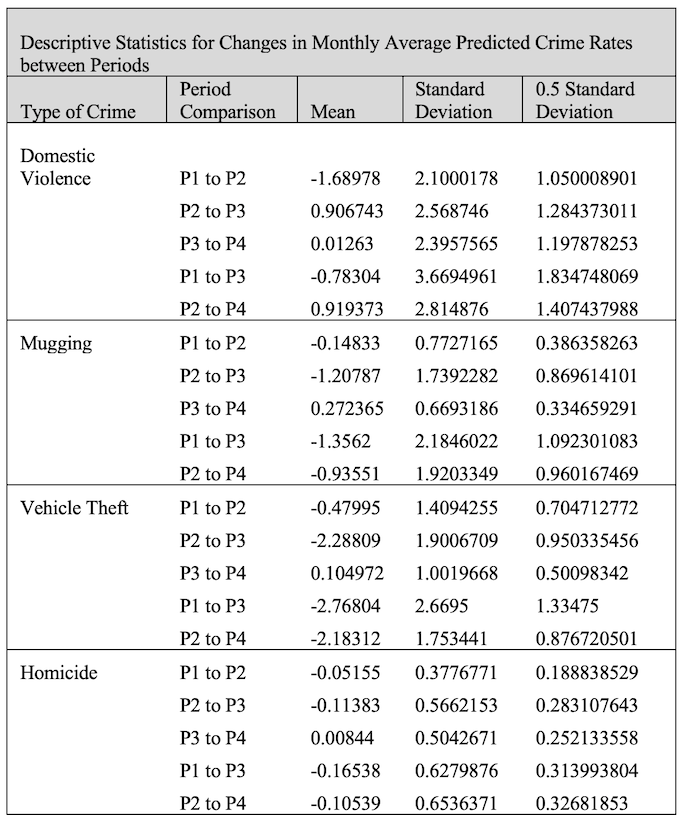
Table 2. Descriptive statistics for changes in monthly average predicted crime rates between periods.
Results from our first model, found in Tables 3 through 6 depict the rates of domestic violence, muggings, vehicle theft and homicide by state before and after the start of the pandemic in six-month periods for a total of 24 months. For each of these tables, Column 1 depicts the state, and Columns 2, 4, 6 and 8 depict the monthly average rate of each crime per 100,000 residents for each of the four time periods of our analysis beginning in March 2019 and concluding in February 2021. Columns 2 and 4 are the two six-month periods before COVID-19, while Columns 6 and 8 are periods after the onset of the pandemic. Columns 3, 5, and 7 depict the change in crime rate per 100,000 residents between the sequential six-month time periods. Columns 9 and 10 depict the changes in crime rate between Periods 1 and 3, as well as 2 and 4, respectively, which is the difference in crime rates between the same six-month period from the previous year, which enabled our study to account for possible variance that may occur for rates of specific crimes based on seasons. Columns 3,5,7,9 and 10 are color coded to indicate increases or decreases in crime rates per 100,000 residents when comparing two six-month periods of time. An increase in the crime rate more than 0.5 standard deviations above or below the mean change for all states in any of the comparison periods is shaded in red, while a decrease is shaded in green. Any states whose changes in crime rate were less than 0.5 standard deviation above or below the mean change in crime rate for all states was left uncolored, indicating that the crime rate didn’t meaningfully change between the periods compared.
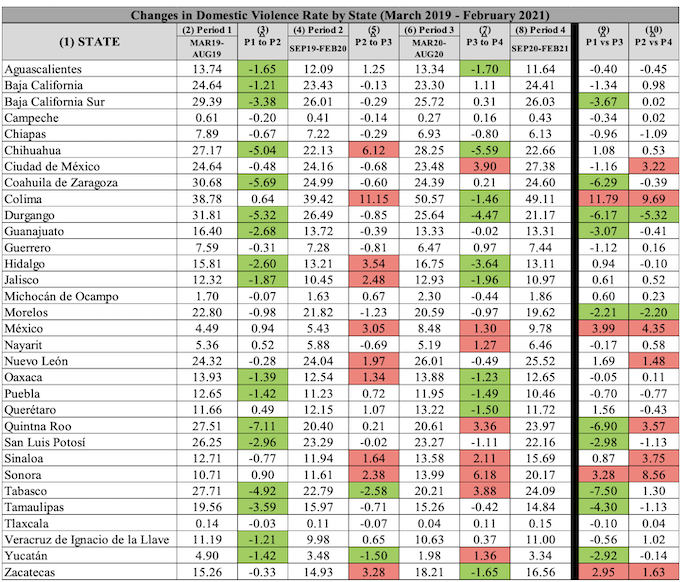
Table 3. Changes in Domestic Violence Rates by State (March 2019 – February 2021).

Table 4. Changes in Mugging Rates by State (March 2019 – February 2021).
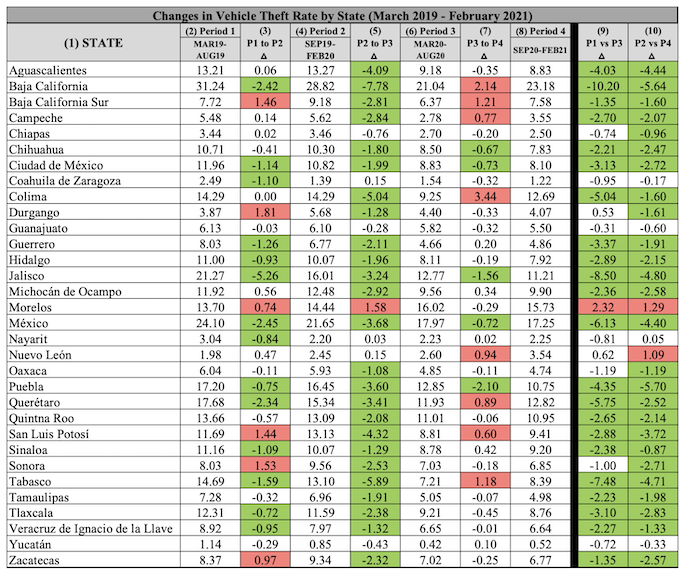
Table 5. Changes in Vehicle Theft Rates by State (March 2019 – February 2021).
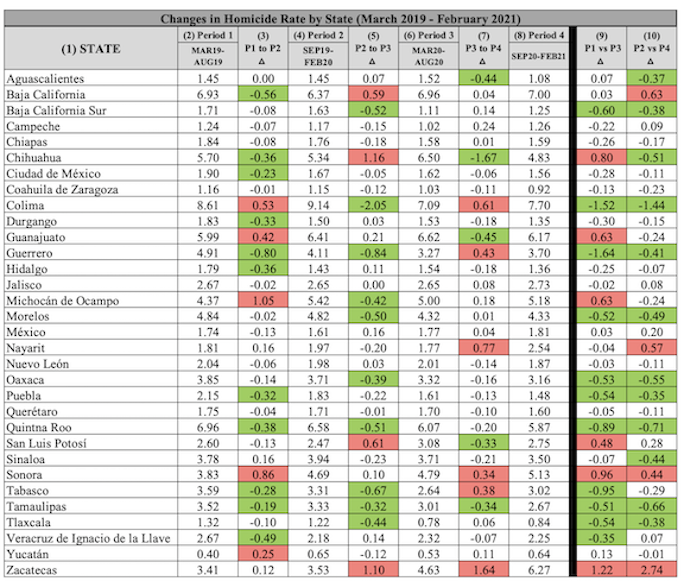
Table 6. Changes in Homicide Rates by State (March 2019 – February 2021).
Results from Tables 3-6, and more specifically how the data was organized by state, answered the third research question, revealing that different crimes responded differently not only to COVID-19 and over time, but they also responded differently from one state to another. Results from Table 4, Changes in Mugging Rates by State and Table 5, Changes in Vehicle Theft Rates by State indicated that many states experienced substantive decreases in these specific crime rates over the first 12 months of the pandemic which aligned with our results from Table 1, t-test Results Comparing Crime Rates Before and After the Start of the COVID-19 Pandemic.
The results from Table 3, Changes in Domestic Violence Rates by State however, added greater insight to our results from our paired sample t-test of Table 1. While Table 1 indicated domestic violence rates across all states in Mexico were relatively unchanged during the first six-months of the pandemic and increased during the second six months of the pandemic, our results in Table 3 revealed that these trends were not standard across all states. Table 3 reveals that the domestic violence rates during the first six months of the pandemic varied extensively by state, with several increasing and decreasing, as well as many remaining unchanged compared to the same period to the prior year. Furthermore, results from Table 3, indicate that the increase in domestic violence observed in Table 1, appears to have been driven by only eight states during period 4, the second six-month period of the pandemic.
Similarly, our results from Table 6. Changes in Homicide Rates by State indicated the most variation by state in our study. While results from Table 1 indicated that homicide rates were relatively unchanged across all states in Mexico before and after the start of the pandemic, many states experienced increases or decreases in their homicide rate in one or both six-month periods of the pandemic compared to the previous year. Despite these variances between all states in Mexico, in the aggregate these changes in homicide rates were not substantive.
How Responsive were Crime Rates to the COVID-19 Infection Rate?
In our final stage of analysis our research aimed to determine how responsive different crime rates were to the COVID-19 infection rate across all states in Mexico through a second multiple linear regression model. In this model, each crime rate per 100,000 residents was the dependent variable while controlling for the COVID-19 infection rate in each state, state population, time, and the crime rate for 2019 for each specific crime.

Table 7. Crime Rates across all states in Mexico and the COVID-19 Infection Rate
Our results found in Table 7 Crime Rates across all States in Mexico and the COVID-19 Infection Rateindicate that COVID-19 rates were not statistically significant for any type of crime when viewed across all states in Mexico, answering our fourth research question. This indicates that crime rates were not associated linearly to COVID-19, meaning that as the COVID-19 infection rate increased or decreased there were no corresponding changes to crime rates.
Discussion
During the first six months of the pandemic across states in Mexico the crime rate for muggings and the crime rate for vehicle theft dropped. In contrast, the crime rate for domestic violence and the crime rate for homicide remained relatively unchanged. Thus, different crimes responded differently to COVID-19. As the pandemic continued beyond its first six months, the crime rates for both muggings and vehicle thefts remained lower in year-over-year comparisons, but during the second six-months of the pandemic there was an increase in the crime rate of domestic violence. Throughout the first 12 months of the pandemic, homicide rates across states in Mexico remained relatively unchanged.
For some crimes, like muggings and vehicle thefts, the overall trends in crime rates were indicative of state-specific experiences. For example, most states reported a substantive decline in muggings during the first six-months of the pandemic and nearly all states reported a substantial drop in vehicle thefts. For other crimes, particularly domestic violence, the general trend of “no change” found in the first part of these analyses may mask important state-to-state differences. The overall rate of reported domestic violence was found to be unchanged in the first six months of the pandemic across all states in Mexico, but a state-to-state examination showed that in some states, like Tabasco, there was a rather large drop in reports of domestic violence while in other states, like Colima, there was a significant increase in the reported rate of domestic violence. Explaining why domestic violence reports responded differently to the pandemic in different states is beyond the scope of this report; however, these state-specific trends may prove fertile grounds for future research to explore the exact mechanisms resulting in crime rates moving up or down.
Finally, despite evidence of changes in crime rates following the onset of the pandemic, it does not appear that reported criminal behavior was responding proportionally to COVID-19. That is, the reported criminal behaviors in a state were not changing in tandem with changes in COVID-19 infection rates. As COVID-19 infection rates increased criminal behavior did not correspondingly decrease (or vice versa). How do these seemingly incompatible findings get reconciled?
First, COVID-19 altered the rates of some types of crimes, specifically muggings and vehicle thefts in the first six months and then also domestic violence in the second six months. These changes in crime rates were not directly reflecting changes in COVID infection rates, suggesting behaviors were altered as people lived through the pandemic, rather than people were directly responding to the conditions of the pandemic. For example, in the early days of the pandemic people significantly restricted their day-to-day travel and movement by staying at home or within their very local community. Evidence of this is available from the Apple Mobility Index, see chart below, showing this decline in daily movement by people in Mexico.
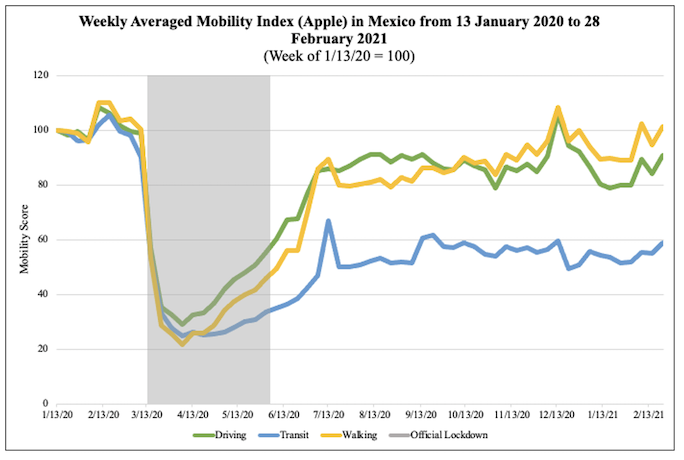
Figure 1. Weekly Mobility Trends in Mexico from 13 January 2020 through 28 February 2021. Source: “Mobility Trends: Change in Routing Requests since January 13, 2020.” Apple, 2021, https://covid19.apple.com/mobility.
During the early days and weeks of the pandemic, government lockdowns and social distancing measures introduced to limit the spread of COVID-19 decreased mobility may have contributed to the depressed levels of certain crimes, particularly vehicle theft and muggings. As routine mobility decreased there were less opportunities to commit certain crimes, which may explain why vehicle theft decreased despite its association with organized crime. And while reduced mobility may provide an explanation for these crimes during the first six months of the pandemic, it does not explain the continued decreases for these crime rates as mobility levels recovered as the pandemic continued.
For the crimes of domestic violence and homicides however, the mobility data above adds a layer of complexity to understanding the potential mechanisms influencing these crime rates. While our study did find that the directionality and changes to domestic violence rates varied by state in both six-month periods after the pandemic began, it is interesting that from September 2020 through February 2021, domestic violence rates generally increased in Mexico despite mobility levels returning close to their pre-pandemic baseline averages.
It may be that mobility is a poor indicator for certain crimes, which may explain why homicide rates were relatively unchanged in the aggregate throughout the pandemic or it could be that the pandemic had little influence on organized criminal behavior regarding homicide. While our research cannot explain the mechanisms behind this, understanding why homicide was largely unaffected by the pandemic may prove valuable to future research.
Conclusion
The central question in this study was directed at discerning the relationship between COVID-19 and criminal activity in Mexico. Four types of criminal activity were chosen—two related to conventional crime (domestic violence and muggings) and two unique to Mexico’s organized criminal landscape (homicides and vehicle theft). The models examined the broad national picture and the subnational level—32 states in total. To ensure a stronger comparative advantage in the study, four periods were analyzed—two before and two during the pandemic. Moreover, to ensure a more accurate reading, criminal activity, which is often seasonal, was adjusted accordingly in our statistical models. Given the two basic public health measures implemented globally, and largely in Mexico, social distancing and stay at home orders, we expected a relatively robust relationship between COVID-19 and criminal activity. The results were counterintuitive.
Homicides did not exhibit a relationship with COVID-19, nor did they change over time. Instead, levels of homicides continued level throughout. This was true at the national and subnational levels. Vehicle theft, a crime also related to organized crime in Mexico, decreased over time and the decrease was statistically significant. Surprisingly, and counterintuitively, domestic violence, expected to go higher as people stayed indoors in favor of social distancing, went down in the first period, but then it ticked up in the second period. Finally, muggings went down as well. The robustness of the changes in crime rates and the directionality of them indicate a rather weak influence of COVID-19 on criminal activity overall. More so if we consider that at the subnational level variation was even greater from state to state.
Endnotes
[1] Lawrence E. Cohen and Marcus Felson, “Social Change and Crime Rate Trends: A Routine Activity Approach.” American Sociological Review. Vol. 44, no. 4. 1979: pp. 588–608, https://doi.org/10.2307/2094589.
[2] Michael Leitner et al., “The Impact of Hurricane Katrina on Reported Crimes in Louisiana: A Spatial and Temporal Analysis.” Professional Geographer. Vol. 63, no. 2. 2011: pp. 244–261, https://doi.org/10.1080/00330124.2010.547156.
[3] Kelly Frailing and Dee Wood Harper, Toward a Criminology of Disaster: What We Know and What We Need to Find Out. New York: Palgrave Macmillan, 2017.
[4] Matthew P. J. Ashby, “Initial evidence on the relationship between the coronavirus pandemic and crime in the United States.” Crime Science. Vol. 9, no. 6. 2020, https://doi.org/10.1186/s40163-020-00117-6.
[5] José Roberto Balmori de la Miyar, Lauren Hoehn-Velasco and Adán Silverio-Murillo. “Drug Lords Don’t Stay at Home: COVID-19 Pandemic and Crime Patters in Mexico City.” Journal of Criminal Justice. Vol. 72. January-February 2021: pp. 1−14, https://doi.org/10.1016/j.jcrimjus.2020.101745.
[6] Patricio R. Estévez-Soto, “Crime and COVID-19: Effects of changes in routine activities in Mexico City.” Crime Science. Vol. 10, no. 15. 2021, https://doi.org/10.1186/s40163-021-00151-y.
[7] José Roberto Balmori de la Miyar, Lauren Hoehn-Velasco, and Adán Silverio-Murillo, “The U‑Shaped Crime Recovery during COVID‑19: Evidence from National Crime Rates in Mexico.” Crime Science. Vol. 10, no. 14, 2021, https://doi.org/10.1186/s40163-021-00147-8.
[8] Natalie Kitroeff, “Mexico Misled Citizens About the Severity of Coronavirus in Its Capital.” New York Times. 21 December 2020, www.nytimes.com/2020/12/21/world/americas/mexico-city-covid.html.
[9] Rodrigo Díaz, “Mobility + COVID 19 in Mexico City: Avoid, Shift, Improve.” Secretaría de Movilidad Ciudad de México. June 2020, www.semovi.cdmx.gob.mx/storage/app/media/mexico-city-mobility-covid.pdf.
[10] L.T. Lewis and J. J. Alford. 1975. “The Influence of Season on Assault.” The Professional Geographer. Vol. 27, no. 2. 2010: pp 214−217, https://doi.org/10.1111/j.0033-0124.1975.00214.x.
[11] Martin A. Andersen and Nicolas Malleson, “Crime Seasonality and Its Variations Across Space.” Applied Geography. Vol. 43. 2013: pp. 25–35, https://doi.org/10.1016/j.apgeog.2013.06.007.
[12] Elyssa Pachico, “Car Theft an $11 Billion Business in Mexico.” Insight Crime. 18 December 2012, https://insightcrime.org/news/brief/car-theft-an-11-billion-business-in-mexico/.
[13] Mike Lasusa, “225,000 Cars Stolen in Mexico Since 2015: Report.” Insight Crime. 29 July 2016, https://insightcrime.org/news/brief/225-000-cars-stolen-in-mexico-since-2015-report/.
[14] Héctor Paredes, Deputy Director of Notification and Epidemiological Records. Información referente a casos COVID-19 en México. 14 April 2020, https://datos.gob.mx/busca/dataset/informacion-referente-a-casos-covid-19-en-mexico.
[15] Instituto Nacional de Estadística y Geografía, Subsistema Nacional de Información de Gobierno, Seguridad Pública e Impartición de Justicia. Encuesta Nacional De Victimización y Percepción Sobre Seguridad Pública. Instituto Nacional De Estadística y Geografía. 2020, https://www.inegi.org.mx/programas/envipe/2020/#Documentacion.
[16] Tiana Bakić Hayden, “Criminalization through Complicity: (Not) Reporting Crime in Mexico City.” Political and Legal Anthropology Review. Vol. 43, no. 2. 2020: pp. 211−227, https://doi-org.ezproxy.rice.edu/10.1111/plar.12372.
[17] Laura H. Atuesta, “Narco-messages as a way to analyze the evolution of organized crime in Mexico.” Global Crime Vol. 18, no. 2. 2016: pp. 100−121, https://doi.org/10.1080/17440572.2016.1248556.
[18] Brian J. Phillips and Viridiana Ríos, “Narco-Messages: Competition and Public Communication by Criminal Groups.” Latin American Politics and Society. Vol. 62, no. 1. 2020: pp. 1−24, https://doi.org/10.1017/lap.2019.43.
[19] Jesús A. Gallegos Segura, “Calidad de la Información y Combate al Crimen.” México Evalúa. 17 November 2016, www.mexicoevalua.org/calidad-de-la-informacion-y-combate-al-crimen/.
[20] Op. Cit., Galleros Segura at note 18.
[21] Tamar Diana Wilson, “Violence against Women in Latin America.” Latin American Perspectives. Vol. 41, no. 1. 2013: pp. 3−18, https://doi.org/10.1177/0094582X13492143.
[22] Ministry of Health. “Exceso de mortalidad por todas las causas, durante la emergencia por COVID-19.” Gobierno de México. 2020-2022, https://coronavirus.gob.mx/exceso-de-mortalidad-en-mexico/.
[23] Douglas Broom, “These Are the OECD Countries Testing Most for COVID-19.” World Economic Forum. 2020, www.weforum.org/agenda/2020/04/these-are-the-oecd-countries-testing-most-for-covid-19.



